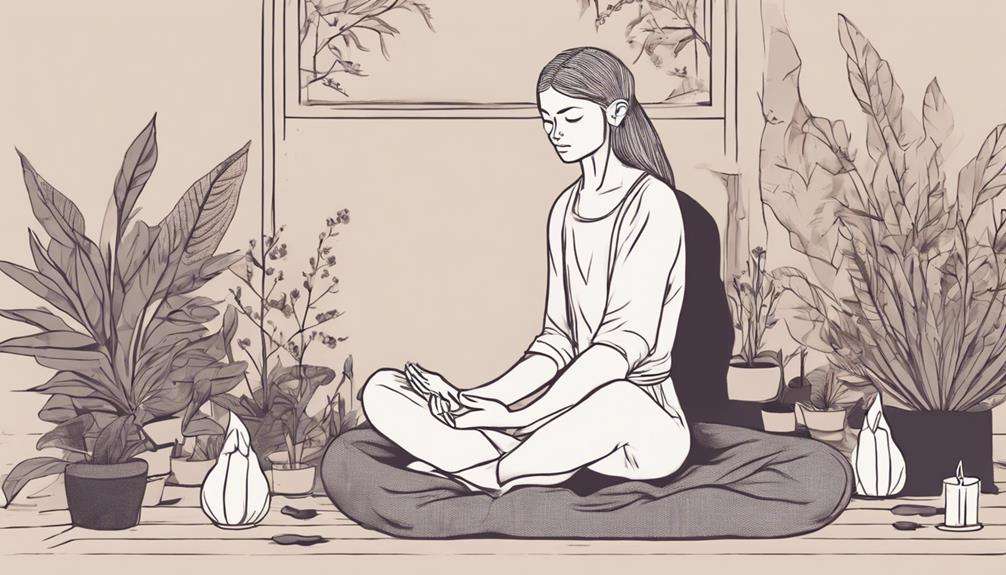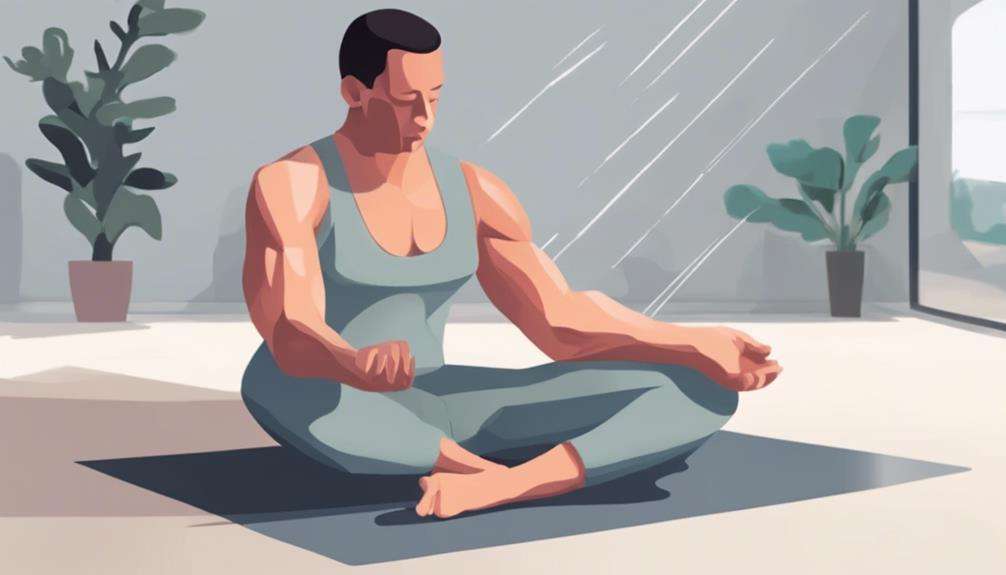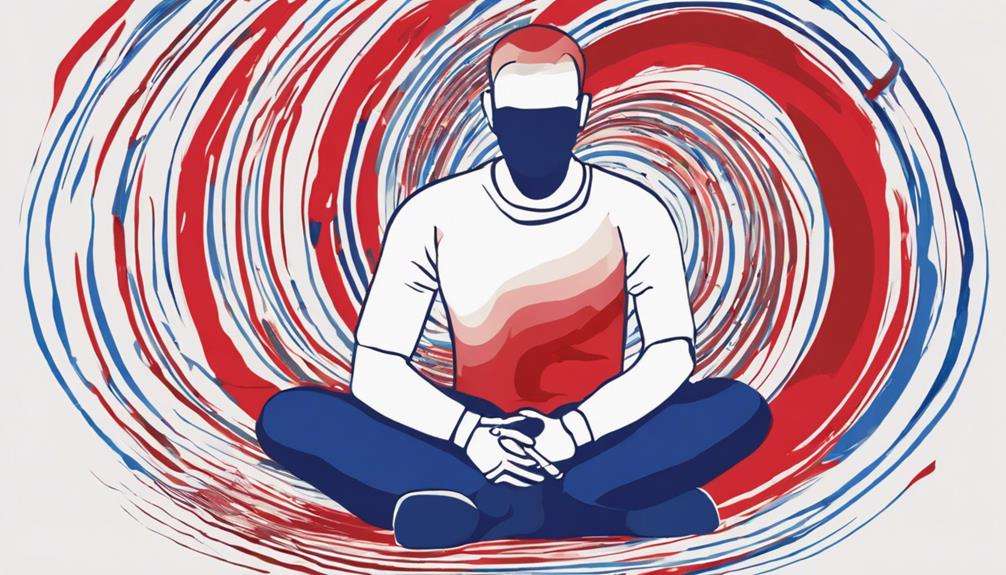Imagine a serene lake, its surface undisturbed by ripples – this tranquility can be reflected in your blood pressure by incorporating mind-body techniques.
Lowering blood pressure is not just about numbers on a monitor; it's about nurturing a harmonious balance within.
These 10 tips offer a holistic approach to achieving best blood pressure levels, each tip revealing a path towards inner calm and physical well-being.
Discover how simple practices can have profound effects on your overall health and vitality.
Key Takeaways
- Engage in yoga, breathing techniques, meditation, and relaxation practices for effective blood pressure management.
- Deep breathing and relaxation methods promote calmness, reducing stress and hypertension.
- Consistent mind-body practices like yoga and meditation lead to improved cardiovascular health.
- Incorporating stress reduction techniques into daily routine aids in lowering blood pressure levels.
Yoga Poses for Blood Pressure
Lower your blood pressure effectively by incorporating specific yoga poses into your daily routine.
Certain yoga poses, such as Savasana (Corpse Pose) and Sukhasana (Easy Pose), are known for promoting relaxation and reducing stress levels, which can help in lowering blood pressure. By engaging in these poses regularly, you can potentially see improvements in your cardiovascular health, including reduced blood pressure levels.
Additionally, yoga poses that focus on deep breathing, like Pranayama (Breath Control), have been shown to calm the nervous system and regulate blood pressure effectively. Studies have demonstrated that individuals with hypertension who practice yoga consistently may experience a decrease in both systolic and diastolic blood pressure measurements.
Breathing Techniques for Hypertension
Shifting from yoga poses to breathing techniques, diaphragmatic breathing stands out as a powerful tool for managing hypertension by activating the body's relaxation response and potentially lowering blood pressure. Deep breathing exercises, such as diaphragmatic breathing, have been linked to reducing stress, lowering heart rate, and promoting relaxation, all of which can contribute to decreased blood pressure levels.
Controlled breathing techniques, like paced breathing or box breathing, play a role in regulating the autonomic nervous system and stabilizing blood pressure. Practices such as abdominal breathing and alternate nostril breathing are accessible tools that can be utilized anywhere to help manage hypertension effectively.
Consistent engagement in breathing exercises has shown promising results in improving oxygen circulation, reducing tension, and supporting overall cardiovascular health, which in turn aids in controlling blood pressure levels. Incorporating these breathing techniques into your routine can be a valuable addition to your hypertension management plan.
Meditation Practices for Lowering BP

Meditation practices, including Mindfulness-Based Stress Reduction (MBSR) and Transcendental Meditation (TM), have demonstrated significant reductions in both systolic and diastolic blood pressure levels. Research indicates that Transcendental Meditation (TM) can lead to sustained decreases in blood pressure over several months, promoting long-term cardiovascular health.
Additionally, studies have linked TM to lower all-cause mortality rates and improved cardiovascular outcomes, underscoring its efficacy in managing high blood pressure. Breathing Awareness Meditation (BAM) has also shown promise in reducing systolic blood pressure, particularly in specific groups like African American ninth graders, showcasing the broad applicability of meditation techniques.
Mindfulness meditation, a fundamental aspect of these practices, aids individuals in developing nonjudgmental awareness in daily life, which contributes to stress reduction and enhances blood pressure control. Embracing meditation as part of your routine may offer a holistic approach to lowering blood pressure and improving overall well-being.
Mindfulness Exercises for High BP
Exploring mindfulness exercises can offer an effective approach for individuals looking to manage high blood pressure and improve cardiovascular health.
Mindfulness-Based Stress Reduction (MBSR) has shown significant reductions in clinic systolic and diastolic blood pressure levels. Additionally, Transcendental Meditation (TM) interventions have proven more effective in decreasing resting systolic and diastolic blood pressure compared to other techniques.
Studies have indicated that TM leads to sustained blood pressure reductions over 6 to 9 months, resulting in enhanced cardiovascular health outcomes and decreased all-cause mortality rates. TM has also been found to be superior to Progressive Muscle Relaxation (PMR) in lowering blood pressure for both men and women.
However, challenges in meditation trials persist due to issues like small sample sizes and the absence of control groups, emphasizing the necessity for further high-quality research in this area.
Embracing mindfulness exercises such as MBSR and TM could be a valuable strategy for individuals seeking to effectively manage high blood pressure and promote overall cardiovascular well-being.
Relaxation Techniques for Blood Pressure

Utilizing relaxation techniques can play a significant role in effectively managing blood pressure by inducing a state of calmness in the body. The relaxation response technique, pioneered by Dr. Herbert Benson, has demonstrated its ability to control high blood pressure and stress-related disorders.
Studies have shown that practicing relaxation response twice a day for 10-20 minutes can lead to decreased inflammation, widened blood vessels, and enhanced cardiovascular health. This technique triggers an increase in nitric oxide levels within the body, which in turn contributes to the lowering of blood pressure.
Remarkably, elderly participants in research successfully regulated their blood pressure through the consistent practice of the relaxation response technique, highlighting its efficacy in blood pressure management. By incorporating these relaxation techniques into your daily routine, you may experience improvements in your blood pressure levels and overall cardiovascular well-being.
Stress Reduction Methods for Hypertension
Incorporating stress reduction methods into your daily routine can greatly impact hypertension management and overall cardiovascular health. Mind-body techniques such as the relaxation response, championed by Dr. Herbert Benson, have shown promise in effectively lowering blood pressure by inducing a state of calmness in the body.
Research indicates that dedicating 10-20 minutes twice a day to practices like meditation or deep breathing can help manage stress-induced high blood pressure. The relaxation response technique has been found to reduce inflammation, widen blood vessels, and enhance cardiovascular health in individuals with hypertension. Studies involving elderly patients have demonstrated successful blood pressure control through the consistent application of mind-body techniques.
Guided Imagery for Lowering Blood Pressure

To effectively lower your blood pressure and enhance cardiovascular health, consider incorporating guided imagery into your stress management routine. Guided imagery involves visualizing peaceful scenes or experiences to promote relaxation and reduce stress, ultimately aiding in lowering blood pressure.
Research has shown that practicing guided imagery regularly can lead to decreased blood pressure levels and improved overall cardiovascular health. By positively impacting the body's stress response, guided imagery becomes a valuable tool for managing blood pressure.
Using guided imagery as a complementary therapy alongside medication and lifestyle changes can further enhance its effectiveness in lowering blood pressure. The calming effects of guided imagery help individuals achieve a state of relaxation, which can translate into lower blood pressure readings and improved well-being.
Body Scan Meditation for BP Control
Body scan meditation promotes relaxation and stress reduction by systematically focusing on different parts of the body. This mindfulness practice can help lower blood pressure by calming both the mind and body, allowing individuals to become more attuned to bodily sensations and release tension.
Research suggests that incorporating body scan meditation into daily routines can not only reduce anxiety but also improve sleep quality and enhance overall well-being. By engaging in this practice regularly, individuals may experience improved blood pressure control and better cardiovascular health.
The benefits of body scan meditation extend beyond just relaxation; they can have a positive impact on various aspects of mental and physical health. Hence, integrating body scan meditation into your daily routine could be a valuable tool in managing blood pressure levels and promoting overall well-being.
Progressive Muscle Relaxation for Hypertension

Progressive Muscle Relaxation (PMR) is a proven method for reducing stress and managing hypertension by systematically tensing and relaxing muscle groups. This technique has demonstrated effectiveness in lowering both systolic and diastolic blood pressure levels.
Regular practice of PMR may lead to sustained reductions in blood pressure over time, offering a simple yet impactful way to enhance cardiovascular health.
Relaxation Techniques Overview
Incorporating Progressive Muscle Relaxation (PMR) into your daily routine can greatly aid in managing hypertension and promoting overall well-being.
PMR is a relaxation technique that involves tensing and then relaxing muscle groups to reduce stress and lower blood pressure in hypertensive individuals. By releasing muscle tension, PMR helps promote relaxation, contributing to decreased blood pressure readings.
Research has shown that regular practice of PMR can lead to sustained reductions in blood pressure over time. This simple and accessible technique can be easily integrated into your daily activities, offering a calming effect on the body and supporting efforts to manage hypertension effectively.
Consider adding PMR to your routine to experience the benefits of stress reduction and improved blood pressure control.
Benefits of PMR
To maximize the benefits of managing hypertension, consider implementing Progressive Muscle Relaxation (PMR) as a key component of your daily routine.
PMR, a relaxation technique involving the systematic tensing and relaxing of muscle groups, has been proven effective in reducing stress and lowering blood pressure in individuals with hypertension. Research supports the use of PMR as a complementary approach to promoting cardiovascular health and stress reduction.
Yoga Nidra for Managing Blood Pressure
Yoga Nidra, a form of guided meditation, offers relaxation techniques that can greatly reduce stress and contribute to better blood pressure control.
The deep state of calmness induced by Yoga Nidra can help lower blood pressure readings and improve overall well-being.
Incorporating Yoga Nidra into your routine may be a valuable tool in managing hypertension and promoting cardiovascular health.
Relaxation Techniques in Yoga
Consider embracing relaxation techniques in yoga, such as Yoga Nidra, as a powerful method for managing blood pressure effectively.
Yoga Nidra, a form of guided meditation, induces deep relaxation, benefiting cardiovascular health and stress reduction. Studies highlight its ability to lower systolic and diastolic blood pressure readings significantly.
By incorporating Yoga Nidra into your daily routine, you can experience reduced stress, improved sleep, and overall well-being. This practice offers a holistic approach to hypertension management, emphasizing the mind-body connection.
Embracing Yoga Nidra can be a valuable tool in your efforts to manage blood pressure and enhance your cardiovascular health. Start exploring the benefits of deep relaxation through the practice of Yoga Nidra for a healthier lifestyle.
Benefits of Deep Relaxation
Embrace the profound benefits of deep relaxation through Yoga Nidra as a powerful method for effectively managing high blood pressure.
Yoga Nidra, a form of deep relaxation, has been shown to help manage hypertension by calming the mind and body, leading to lower blood pressure levels.
Research indicates that regular practice of Yoga Nidra can reduce stress, improve cardiovascular health, and induce a state of deep relaxation while maintaining awareness.
This makes it a valuable tool for managing high blood pressure. By incorporating Yoga Nidra into your daily routine, you can contribute to lowering your blood pressure and enhancing your overall well-being.
Consider adding this mindfulness meditation practice to your lifestyle for its proven benefits in managing high blood pressure.
Stress Reduction Through Yoga
To effectively manage high blood pressure, incorporating stress reduction techniques like Yoga Nidra into your daily routine can greatly contribute to improving your cardiovascular health and overall well-being.
Yoga Nidra, a form of guided meditation, is known for inducing deep relaxation through practices such as deep breathing, body scanning, and visualization. Studies have shown that regular practice of Yoga Nidra can help lower blood pressure by calming the nervous system and promoting relaxation of both the mind and body.
These guided sessions typically last between 20-45 minutes and can serve as a valuable tool in managing hypertension. By integrating Yoga Nidra into your daily regimen, you can support your cardiovascular health and work towards reducing stress levels for a healthier blood pressure profile.
Frequently Asked Questions
How Do I Reset My Brain to Lower My Blood Pressure?
To reset your brain and lower blood pressure, practice brain relaxation through mindfulness exercises, stress management, deep breathing, positive visualization, and meditation benefits. These relaxation techniques enhance the mind-body connection, promoting overall well-being.
How Can I Mentally Control My Blood Pressure?
To mentally control your blood pressure, practice meditation techniques, breathing exercises, visualization techniques, stress management, and relaxation techniques. Incorporate mindfulness practices, positive affirmations, and cognitive therapy into your daily routine for improved cardiovascular health and well-being.
How Do I Stop Overthinking My Blood Pressure?
To stop overthinking your blood pressure, focus on stress management, practice mindfulness, do breathing exercises, use relaxation techniques, consider meditation benefits, explore cognitive therapy, use positive affirmations, and adopt self-care strategies. These steps can help you maintain a healthy mindset.
What Is the Trick to Lower Blood Pressure?
To lower blood pressure, practice stress management, deep breathing, meditation, relaxation exercises, mindfulness, positive affirmations, visualization therapy, and yoga poses. These mind-body techniques induce the relaxation response, reducing heart rate and ultimately lowering blood pressure.
Conclusion
To sum up, incorporating mind-body techniques like yoga, meditation, and relaxation responses into your daily routine can help lower blood pressure levels.
Did you know that a study published in the Journal of Hypertension found that practicing these techniques for just 10-20 minutes twice a day can lead to a significant reduction in blood pressure?
By prioritizing your mental and physical well-being, you can improve your cardiovascular health and overall quality of life.






